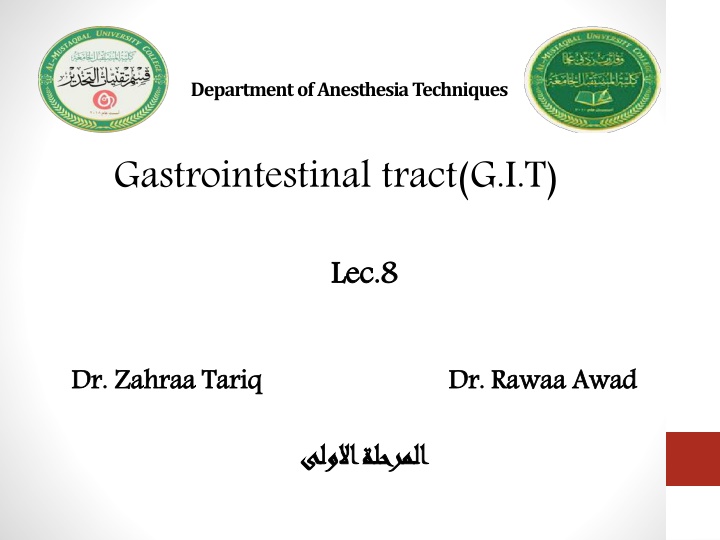
Gastrointestinal Tract: An Overview of Digestive System
Explore the anatomy and functions of the gastrointestinal tract, including the pharynx, esophagus, stomach, and small intestine. Learn how these organs work together to digest and absorb food while excreting waste products. Delve into the mechanical processes and functions of each component, from the oral cavity to the small intestine.
Download Presentation

Please find below an Image/Link to download the presentation.
The content on the website is provided AS IS for your information and personal use only. It may not be sold, licensed, or shared on other websites without obtaining consent from the author. If you encounter any issues during the download, it is possible that the publisher has removed the file from their server.
You are allowed to download the files provided on this website for personal or commercial use, subject to the condition that they are used lawfully. All files are the property of their respective owners.
The content on the website is provided AS IS for your information and personal use only. It may not be sold, licensed, or shared on other websites without obtaining consent from the author.
E N D
Presentation Transcript
DepartmentofAnesthesiaTechniques Gastrointestinal tract(G.I.T) Lec. Lec.8 8 Dr. Dr. Zahraa Zahraa Tariq Tariq Dr. Dr. Rawaa Rawaa Awad Awad
The G.I.T comprises 1 1. The Gastrointestinal Tract 2 2. Accessory Organs. The pharynx, esophagus, stomach, small intestine, and large intestine. The 1. Teeth 2. Tongue 3. Glandular organs such as salivary glands, liver, gallbladder, .and pancreas The G.I.T comprises . The Gastrointestinal Tract . Accessory Organs. The gastrointestinal tract gastrointestinal tract consists of the oral cavity, The accessory organs are accessory organs are the
Functions 1. Digest and absorb food. 2. Excrete the waste products. The Is the 1st part of G.I.T. Functions 1. Mechanical processing via the action of the teeth, tongue, and palatal surfaces. 2. Lubrication by mixing food material with mucus and salivary gland secretion. 3. Limited digestion of carbohydrates and lipids Functions of G.I.T: of G.I.T: The Oral Oral Cavity Cavity: : Functions of of Oral Oral Cavity Cavity: :
The Pharynx The pharynx serves as a passageway of food material to the esophagus. The The esophagus's primary function is to empty food materials into the stomach via waves of contraction of its muscle known as peristalsis. The Once the food material arrives in the stomach, it can be temporarily stored and mechanically and chemically broken down by the actions of stomach acids and enzymes. The Pharynx The Esophagus Esophagus The Stomach Stomach
The 1 1. . Mechanical The muscular layers of the stomach assist in the mixing and churning of food that is essential in the formation of chyme. 2 2. . Digestive The major function of gastric juice in the stomach is to aid in protein digestion. 3 3. . Protective The acidity of the stomach brought on by hydrochloric acid destroys most of the microorganisms ingested with food. 4 4. Hemopoietic The intrinsic factor that produced from the parietal cell of the stomach is essential in the absorption of vitamin B12. It binds to B12, allowing for proper absorption at the ileum of the small intestine. The Function Mechanical Function of of Stomach Stomach Digestive Protective Hemopoietic:
Small The small intestine has three segments: 1. Duodenum 2. Jejunum 3. Ileum. The small intestine is the next location where digestion takes place. 90 small Small Intestine Intestine: : 90% % of of food small intestine food absorption intestine. . absorption occurs occurs in in the the
Large Intestine: The large intestine consist of 4 parts: 1. The Cecum 2. Colon 3. Rectum 4. Anal Canal. Functions 1. Reabsorption of water and other substances such as bile salts. Large Intestine: Functions of large intestine: of large intestine: 2. Prepares fecal material for ejection from the body.
Accessory Glandular Organs 1 1. Liver Is the largest gland and one of the vital organ of the body. Functions 1. Formation and secretion of bile. 2. Nutrients and vitamin metabolism. 3. Inactivated some substances (toxins, steroid, and other hormones) 4. Synthesis of plasma proteins. 2 2. The Gallbladder is a small sac that sits just under the liver. Function Accessory Glandular Organs . Liver Functions of the liver: of the liver: The Gallbladder Function: storage of bile
3 3- -Pancreas The pancreas is an elongated, tapered organ located across the back of the belly, behind the stomach. Functions The pancreas has digestive and hormonal functions: 1. The exocrine gland help break down carbohydrates, fats, proteins, and acids in the duodenum. 2. The endocrine gland A. B. B. S Somatostatin being released. Pancreas: : Functions of The Pancreas: of The Pancreas: The exocrine gland in the pancreas secretes enzymes that The endocrine gland produces hormones such as Insulin omatostatin, , which inhibits insulin and glucagon from Insulin and glucagon glucagon, , which regulate blood glucose levels.





















